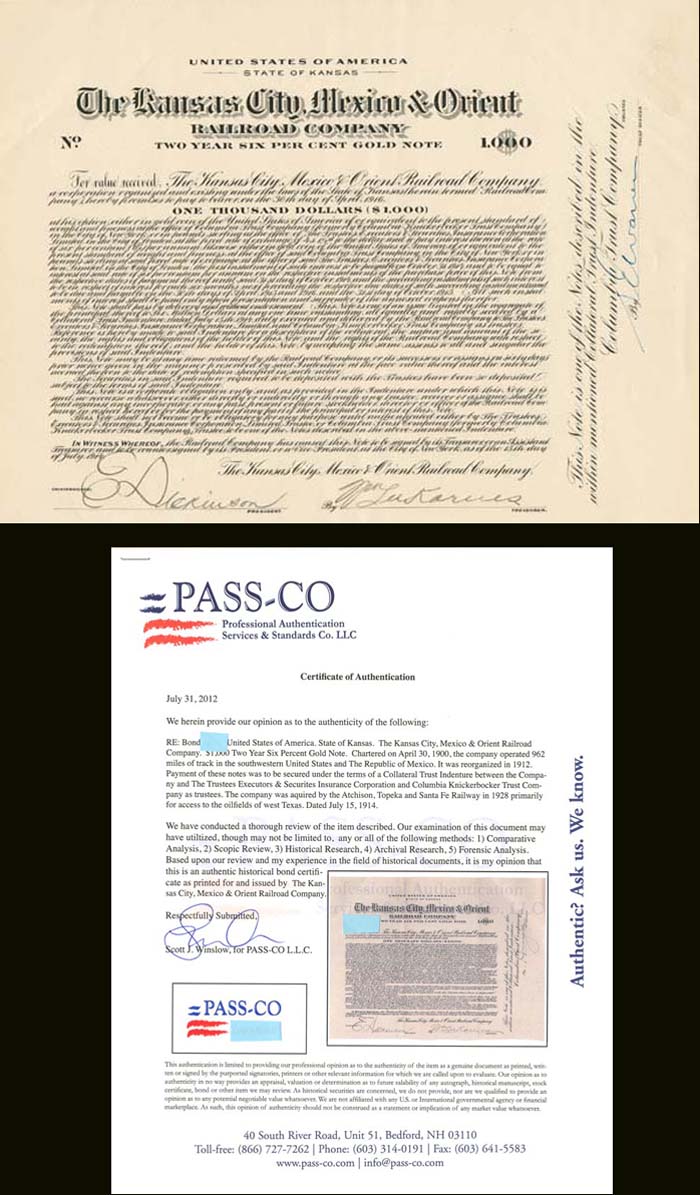$1,000 Kansas City, Mexico and Orient Railroad Co. - Uncanceled Bond
Inv# FB6104 Bond
United States
Uncanceled $1,000 Two Year 6% Gold Bond of the United States of America. State of Kansas and Mexico.
Chartered on April 30, 1900, the company operated 962 miles of track in the southwestern United States and The Republic of Mexico. It was reorganized in 1912. Payment of these notes was to be secured under the terms of a Collateral Trust Indenture between the Company and The Trustees Executors & Securities Insurance corporation and Columbia Knickerbocker Trust Company as trustees. The company was acquired by the Atchison, Topeka and Santa Fe Railway in 1928 primarily for access to the oilfields of west Texas. The Atchison, Topeka and Santa Fe Railway (AAR reporting marks ATSF), often abbreviated as Santa Fe, was one of the larger railroads in the United States. The company was first chartered in February 1859. Although the railway was named in part for the capital of New Mexico, its main line never reached there as the terrain made it too difficult to lay the necessary tracks (Santa Fe was ultimately served by a branch line from Lamy, New Mexico).
The Santa Fe's first tracks reached the Kansas/Colorado state line in 1873, and connected to Pueblo, Colorado in 1876. In order to help fuel the railroad's profitability, the Santa Fe set up real estate offices and sold farm land from the land grants that the railroad was awarded by Congress; these new farms would create a demand for transportation (both freight and passenger service) that was, quite conveniently, offered by the Santa Fe. Ever the innovator, Santa Fe was one of the pioneers in intermodal freight service, an enterprise that (at one time or another) included a tugboat fleet and an airline, the short-lived Santa Fe Skyway. A bus line allowed the company to extend passenger transportation service to areas not accessible by rail, and ferry boats on the San Francisco Bay allowed travellers to complete their westward journeys all the way to the Pacific Ocean. The Atchison, Topeka and Santa Fe Railway officially ceased operations on December 31, 1996 when it merged with the Burlington Northern Railroad to form the Burlington Northern and Santa Fe Railway.
The Kansas City, Mexico and Orient Railway, started in 1900 by American railroad entrepreneur Arthur Edward Stilwell, was the predecessor of the Chihuahua al Pacífico railroad in Mexico. It was intended to reach the Pacific Ocean at Topolobampo, Sinaloa.
The United States portion was incorporated in 1900 as the Kansas City, Mexico, and Orient Railway. It was completed between Wichita, Kansas, and Alpine, Texas. Grading took place between El Dorado and Bazaar, Kansas. Primary shops were first located in Fairview, Oklahoma. In 1910, the Fairview shops were destroyed by fire and the shops were then re-established in Wichita. The railroad was forced into bankruptcy in 1912, but its receiver, William T. Kemper, was to make a fortune when oil was discovered under its tracks. In 1914, it was reorganized as the KCM&O Railroad. Another reorganization in 1925 returned it to its original name. It was popularly called The Orient railroad.
At the end of 1925, KCM&O and KCM&O of Texas (the portions of interstate railroads in Texas were required to be under unique charters) together operated 859 miles of track over 738 miles of right of way; they reported a total of 330 million net ton-miles of revenue freight and 8 million passenger-miles. The KCM&O was acquired by the Atchison, Topeka and Santa Fe Railway in 1928, mainly to gain access to the West Texas oil fields. The Santa Fe then sold the Mexican portions. The railway reached Presidio in 1930 and the Presidio–Ojinaga International Rail Bridge was built.
Operating rights on the portion from San Angelo Junction (65 miles NEE of San Angelo) to Presidio (known as South Orient Rail Line) later were awarded to Texas Pacifico Transportation.
A bond is a document of title for a loan. Bonds are issued, not only by businesses, but also by national, state or city governments, or other public bodies, or sometimes by individuals. Bonds are a loan to the company or other body. They are normally repayable within a stated period of time. Bonds earn interest at a fixed rate, which must usually be paid by the undertaking regardless of its financial results. A bondholder is a creditor of the undertaking.










Ebay ID: labarre_galleries